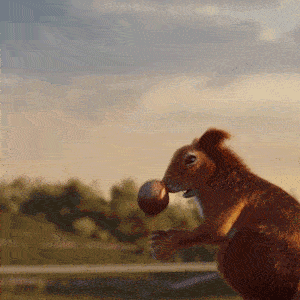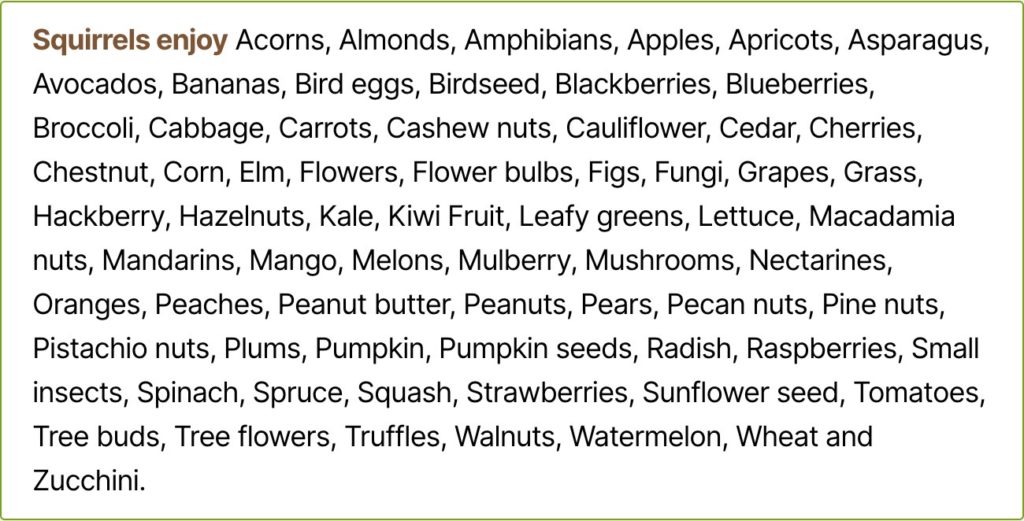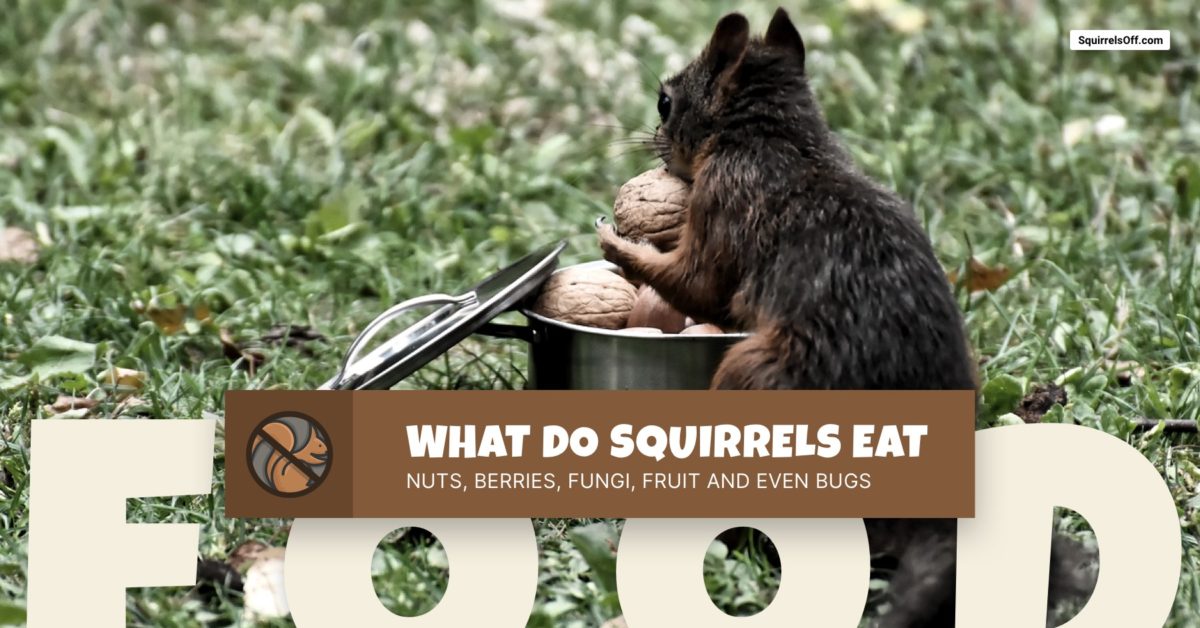When you think of a squirrel, you may envision up a furry rodent with a fluffy tail, clutching an acorn close to it’s mouth. And, while they do enjoy acorns, squirrels tend to eat a rather varied diet solely dependent upon the area in which they live. Although they typically maintain a five mile radius, some have been known to go as far as ten miles away from home in search of resources and fun. Whether you are looking to repel squirrels from your garden, or simply interested in learning more about their diet, we have gathered all the information you need moving forward.

Overall, squirrels enjoy snacking on nuts, berries, fungi, fruit and even bugs. However, a squirrel’s diet differs from type to type, of which they are classified into three categories: flying squirrel, ground squirrel and tree squirrel. The type of squirrel also influences how any given squirrel goes about in search of food, while their own unique predators affect how and when they gather food, as well. For example, flying squirrels are completely nocturnal and venture out for food at night, whereas tree and ground squirrels are diurnal and stay awake during the day.
More often than not, squirrels consume an omnivorous diet of various insects, fruit, plants, and seeds. While it may seem strange to consider squirrels as meat-eaters, each type regularly incorporates some form of animal flesh into their diet. Considered to be the most carnivorous of all types, the Southern flying squirrel is known to consumes birds, bird eggs, as well as decaying flesh (or carrion). Ground squirrels may even go as far as to eat the young of their most prevalent predator: snakes. Tree squirrels, however, will readily feast on the organs of dead deer (carrion), in addition to the nestlings of ground and tree birds. In order to prevent breeding competition, all types of male squirrels will practice infanticide and cannibalism by eating young squirrel pups.
Hibernation seems to be a topic of confusion for many people, especially in reference to squirrels. Did you know tree squirrels don’t hibernate at all? Most types of squirrels typically become inactive during the cold, winter season, spending more time in their homes to conserve energy. This is why squirrels hide food through the summer and fall, burying acorns across the forest floor for harvesting later on, known as a food cache. Although some hidden food will be pillaged by other squirrels, some birds will also seek out a food cache in hopes of an easy dinner.
As food becomes scarce, particularly in the winter, tree squirrels will return to a food cache in order to retrieve nuts and seeds. Because of possible scroungers, Gray squirrels and Red squirrels may be spotted creating faux caches, wherever they pretend to bury food, before moving onto the location of a real food cache. Squirrels also appear to have a decent memory, or episodic memory, in regard to food locations – possibly referencing landmarks as they go. However, many forgotten food caches commonly lead to the regeneration of forests, as well as the introduction of new types of trees. Grey squirrels are the most notable contributors of seed dispersion, unrivaled by any other type of squirrel.

Some homeowners take great joy in feeding squirrels, sometimes going as far as to keep them as pets (please check local laws in regard to legality). It is vitally important to ensure wild squirrels, and pets alike, are fed meals that are healthy, while also contributing to a hearty diet. Although it may seem perfectly safe to feed squirrels whatever human foods happen to be in your cabinet, it is particularly crucial to avoid certain items that disagree with them. Because they are not picky eaters, people should take great care in avoiding cashews, sunflower seeds, pine nuts, and more.
Two prominent products that should be avoided include:
- Bread is a classic favorite for feeding all manner of wildlife, such as deer, ducks and squirrels. While it may be cheap and widely available, bread doesn’t offer much as far as nutrients go. In fact, many types of bread contains large amounts of sugar, as well as cellulose, which negatively impact most mammals. In fact, cellulose (a dietary fiber) is particularly hard for squirrels to digest. This is in addition to the well-known reality that the sugar levels in bread surpass that of some candy.
- Dried Corn is another dangerous food for squirrels. Although fresh corn, straight from the cob, may be safe for some pet squirrels, dried field corn tends sour quickly. Because it may sour in a short amount of time, dried corn is a potential breeding ground for various types of toxic mold. Squirrels are also prone to overeating, even to their own detriment, so pieces of corn must be fed in moderation only.
Because squirrels love to feed off the fallen seeds of bird feeders, they often find themselves lured into gardens for the sake of an easy meal. As birds eat, the contents said feeders falls onto the ground, and creates a buffet for various ground animals – especially squirrels. Individuals who appreciate squirrels will utilize squirrel specific feeders to draw them in for a show. However, that’s not necessarily the case for all homeowners. If you find squirrels to be more of a nuisance in your garden, rather than a joy, you might want to consider adding squirrel-proof bird feeders to your yard, instead. By utilizing harmless hardware and techniques, squirrel-proof feeders can help you repel squirrels while continuing to attract the most exquisite birds.
- 10 Ways to Squirrel Proof a Bird Feeder - February 7, 2020
- How to Keep Squirrels Out Of Bird Feeder - January 2, 2020
- How To Get Rid Of Squirrels - January 1, 2020

